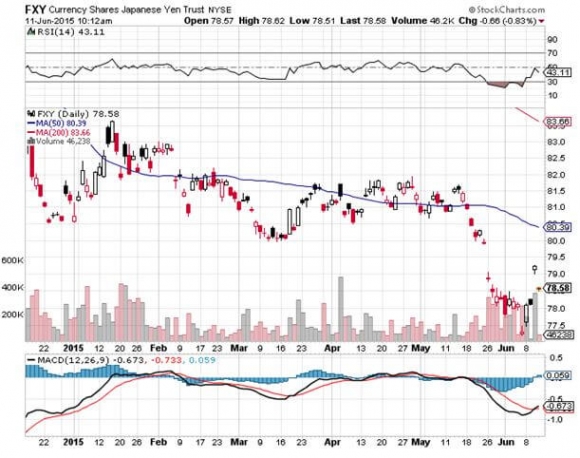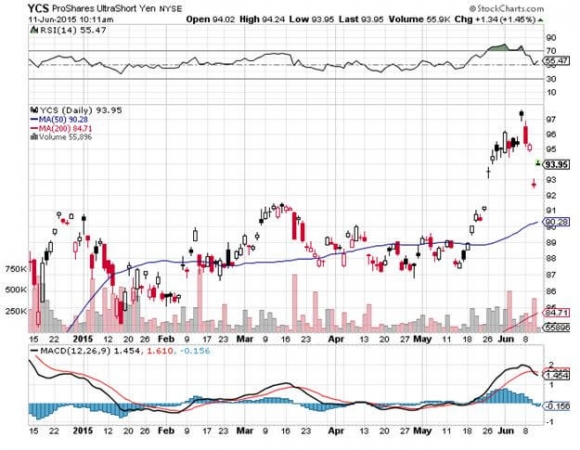As a potentially profitable opportunity presents itself, John will send you an alert with specific trade information as to what should be bought, when to buy it, and at what price. This is your chance to ?look over? John Thomas? shoulder as he gives you unparalleled insight on major world financial trends BEFORE they happen.
Trade Alert - (FXY) - UPDATE
Buy the Currency Shares Japanese Yen Trust (FXY) July, 17, 2015 $81-$83 in-the-money vertical bear put spread at $1.80 or best
Opening Trade
6-10-2015
expiration date: July 17, 2015
Portfolio weighting: 10%
Number of Contracts = 56 contracts
There is nothing like waking up in the morning and discovering that the short position I slapped on only yesterday was in complete free fall.
Fortunately, I used Bank of Japan governor Haruhiko Kuroda?s ill advised comments yesterday to sell short the beleaguered Japanese currency.
Specifically, he said that the yen was getting oversold, and was unlikely to decline any further. His words triggered a ferocious round of profit taking among hot money shorts that moved the yen a massive 1.5% upward.
He also provided a gift for people like me and my readers looking to reestablish new yen shorts.
My advice that you could execute this spread anywhere in the $1.80-$1.90 range and have a good shot at making money in the five weeks to expiration over the slow summer period proved spot on.
At this morning?s middle market mark of $1.975 for the Currency Shares Japanese Yen Trust (FXY) July, 17, 2015 $81-$83 in-the-money vertical bear put spread, you can already realize 87.5% of the maximum potential profit of the spread, scooping up a one day, overnight profit of 9.7%. No bad for the dog days of summer.
I continued with these comments:
?However, with a large number of contracts, commissions will be an issue for some of you. So its better to factor in all your costs before you pull the trigger.
Better yet, call you broker and ask for a lower commission rate to facilitate a larger number of trades. You will be amazed at how fast they will agree to this.
If for any reasons you can?t, or don?t want to do the options, just buy the ProShares Ultra Short Yen ETF (YCS) outright. You?ll be taking on more risk, but over the longer term will make more money.?
A short in the Japanese yen has been a core position of my model trading position for the last three months. I have weaved in and out of the market almost every month.
It does help that I have been trading the yen for 41 years.
To understand the fundamental argument for the short play, I will paraphrase William Shakespeare; ?Oh, how do I despise the yen, let me count the ways.?
I?m sure the bard of Avon would have come up with a line of iambic pentameter similar to this if he were a foreign exchange trader.
I firmly believe that a short position in the yen should be at the core of any hedged portfolio for the next decade.
To remind you why you hate the currency of the land of the rising sun, I?ll refresh your memory with this short list:
1) With the world?s structurally weakest major economy, Japan is certain to be the last country to raise interest rates. Interest rate differentials between countries are the single greatest driver of foreign exchange rates. That means the yen is taking the downtown express.
2) This is inciting big hedge funds to borrow yen and sell it to finance longs in every other corner of the financial markets. So ?RISK ON? means more yen selling, a lot.
3) Japan has the world?s worst demographic outlook that assures its problems will only get worse. They?re just not making enough Japanese any more. Countries that are not minting new consumers in large numbers tend to have poor economies and weak currencies.
4) The sovereign debt crisis in Europe is prompting investors to scan the horizon for the next troubled country. With gross debt well over a nosebleed 270% of GDP, or 135% when you net out inter agency crossholdings, Japan is at the top of the list.
5) The Japanese ten-year bond market, with a yield of only 0.53%, is a disaster waiting to happen. It makes US Treasury bonds look generous by comparison at 2.46%. No yield support here whatsoever.
6) You have two willing co-conspirators in this trade, the Ministry of Finance and the Bank of Japan, who will move Mount Fuji if they must to get the yen down and bail out the country?s beleaguered exporters and revive the economy.
When the big turn inevitably comes, we?re going to ?130, then ?150. That works out to a price of $150 for the (YCS), which last traded at $90.50. But it might take a few years to get there.
If you think this is extreme, let me remind you that when I first went to Japan in the early seventies, the yen was trading at ?305, and had just been revalued from the Peace Treaty Dodge line rate of ?360. To me the ?120.78 I see on my screen today is unbelievable.
The best execution for the options can be had by placing your bid for the entire spread in the middle market and waiting for the market to come to you. The difference between the bid and the offer on these deep in-the-money spread trades can be enormous.
Don?t execute the legs individually or you will end up losing much of your profit.
Keep in mind that these are ballpark prices only.
Spread pricing can be very volatile, and the liquidity in the options market isn?t that great these days.
Here are the specific trades you need to execute this position:
Buy 56 July, 2015 (FXY) $83 puts at?????$4.00
Sell short 56 July, 2015 (FXY) $81 puts at..?.$2.20
Net Cost:??????????????????.....$1.80
Profit at expiration: $2.00 - $1.80 = $0.20
(56 X 100 X $0.20 ) = $1,120 or 1.12% profit for the notional $100,000 portfolio.





